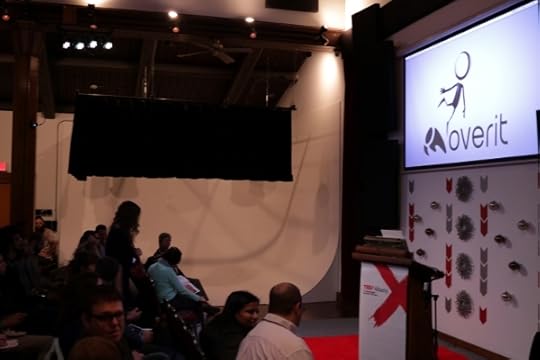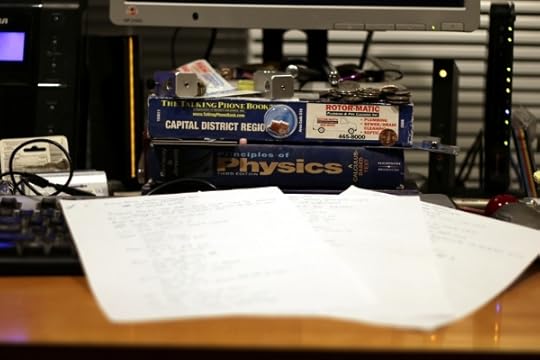Chad Orzel's Blog, page 16
December 9, 2015
100/366: Indomitable Spirit
As noted a couple of days ago, this was a big martial arts week at Chateau Steelypips, with The Pip’s first-ever belt test on Monday, and SteelyKid testing for her brown belt tonight. Unfortunately, tonight was also a first, namely the first belt test she’s failed.
This was, sadly, entirely predictable, as her teacher has really tightened the requirements for tests of late, and said a while back that they would be required to do not only the form for the belt they were testing for, but the previous belt, as well. And I’ve been trying for three days to get her to run through the red-belt form to refresh her memory. But she refused, and paid the price.
She did, however, bounce back pretty well and broke two (really thin) boards with a jumping back kick:
So, let’s hear it for indomitable spirit. Also, I got this nice shot of her during one of the earlier stages of the test:

SteelyKid doing punches at her belt test.
And that’s the latest from here. A programming note, now: we’re heading to Florida for a few days, leaving absurdly early tomorrow morning. I’ll be taking the camera, of course, and will be taking pictures, but I can’t swear I’ll have time to edit and post them. In which case you may get a giant photo dump next week when we’re back. You’ll just have to wait and see…
099/366: Medicine
When we had our vetinary adventure back on Saturday, they drew blood for some tests. These showed that Emmy’s kidney function is somewhat impaired, leading to yet more tests, and as of last night an extensive regimen of new stuff:

Emmy’s new medication.
That’s some new kidney-friendly food (in both dry and canned varieties), a drug for her kidneys, an antibiotic in case she has a bladder infection (something she’s been prone to; those test results are yet to come back), and a bunch of different vitamins. This on top of the antacid pills we were told to start giving her a couple days ago.
What a drag it is getting old…
Unfortunately, one of these things doesn’t agree with her, as her stomach is upset this morning. So it looks like we have yet another trip over to Sunnyside in our future…
December 7, 2015
098/366: Little Dragon
It’s a big week in Chateau Steelypips for martial arts and cute-kid photos. On the heels of SteelyKid’s first competition this past weekend, we have the Pip’s first belt test tonight (and SteelyKid is testing for her brown belt Wednesday, so you should probably expect one more kid-martial-arts photo before all’s said and done…).
Tonight’s test was for the “Little Dragons” class for 3-4-5-year olds, and was kind of hilarious. There was a lot of enthusiasm, but also a good deal of fuzziness on the difference between “right” and “left,” and their interpretation of push-ups was simply indescribable. The kids all kicked and punched pads with great enthusiasm (even the kid whose kihap on kicks was “OUCH!”), and they all got to break a board.
So here’s The Pip with his new accessories:

The Pip with his new belt, his certificate, and the board he broke during his belt test.
And here he is getting congratulated by Master Tocco:

The Pip getting his new belt at taekwondo.
And it’s on to Wednesday and SteelyKid’s much more intense test…
December 6, 2015
097/366: Long Live the Queen
SteelyKid’s taekwondo competition was the most time-consuming event of yesterday, but not the most stressful. Before we went down to Duanesburg for the tournament, Emmy gave us a bit of a scare.
Emmy is not by any stretch a young dog– she was a year old when we got her in 2003, so she’s 13– but she’s pretty spry. Over the last few weeks, though, she slowed down very dramatically. Initially, I didn’t think much of it– she was unenthusiastic about eating her kibble, but that happens a lot when we get near the end of a bag, and she kept eating treats. And she was moving slowly and stiffly on our morning and evening walks, but again, she’s old for a dog, especially one her size.
Yesterday morning, though, she was in a really bad way. She barely wanted to eat her morning treats, wouldn’t even look in the bowl of kibble, and when I put the leash on her to take her for our morning walk, we barely got into the next-door neighbor’s yard before she planted her legs and Would Go No Further. When I looked at her, I could see she was laboring to breathe.
I called the vet, and loaded her into the car, fully expecting that I wouldn’t be bringing her home that day, possibly ever again.
When we got to the vet, he noticed the same breathing thing, and mentioned that her eyes and gums looked pale. He ran through a bunch of stuff– hooking her to a pulse-ox machine, poking and checking her all over, and drawing blood for tests. After looking at the blood under a microscope, he came back, rooted in the fridge for a bit, then gave her a shot of some sort of steroid (I didn’t catch the name). He said the blood didn’t show signs of the anemia that sometimes hit German Shepherd type dogs, but there’s an adrenal gland thing that sometimes hits older dogs, the canine equivalent of Addison’s Disease.
I asked what we should be looking for, and he said “Well, if twelve hours from now she’s like a whole new dog, then that would be a good sign that I’m probably right…”
And damn if he wasn’t right. I mean, it’s not like we rolled back the clock to 2007 or anything, but I dropped her at home and then took SteelyKid off to taekwondo, and when I came back, Emmy was back, too. She had perked up, she ate her dinner without needing to be coaxed, and was downright sprightly on our evening walk. And she’s been great today, too.
So, let’s hear it for modern (vetinary) medicine, and a good while yet with the Queen of Niskayuna, shown here on our walk this morning worrying that I’m not actually going to give her the treat I have in the same hand as my camera:

Emmy, the Queen of Niskayuna.
(She got the treat, because she’s the best Emmy ever…)
December 5, 2015
096/366: SilverKid!
I feel a little bad that I’m doing two photo-of-the-day posts in a row that are just pictures of SteelyKid, but my day today was dominated by a taekwondo tournament down in Duanesburg, SteelyKid’s first actual competition. And she got second place:

SteelyKid with her silver medal from today’s taekwondo tournament.
This is somewhat less impressive than you might think, because she was in a division of three. She actually lost her one bout fairly badly, but did slightly better than the third girl in the field, thus getting the silver medal. But again, it was her first time competing, and on top of that, she got kicked in the eye at one point (which got her opponent reprimanded by the ref) but fought through that and got some good shots in late in the bout.
So, we’re very proud of her effort and determination. And while there were a few tears shed over the kick to the face, she was very pleased with her medal, and I suspect we’ll be going to more of these tournaments in the future…
(From the parental side, this was about four hours of standing around with about two minutes of incredibly nerve-wracking action in the middle. (We could’ve cut an hour plus off that, but we stuck around to support the boys on her team, whose sparring started after the girls’ finished…) This is a slight improvement over my sister’s swim meets back in the day, because 1) the gym was slightly less hot and humid than a typical pool, and 2) once the actual matches started, there were always kids kicking each other in the head, which is way more entertaining than distance races in swimming.
(But, I have to say, it was not at all easy to stand on the side and watch another kid kicking SteelyKid repeatedly. Even though she’s been doing this for a good while now– combat sports are rough for parental instincts…)
095/366: Second-Grade Movember
Both SteelyKid’s elementary school and her after-school day care had “book fairs” this week. These include a bunch of display cases full of books at various reading levels, and also a couple of tables of plastic toy crap. One of the marginally less crappy plastic toys was a marker with ink that fluoresces in UV light but is otherwise inevitable, and SteelyKid kept bugging me to get one of those. I eventually caved, because it required only loaning her one dollar to supplement her allowance, and it was worth a buck to me not to have to listen to the complaints that would’ve ensued otherwise.
Of course, part of the reason she wanted one is that one of her classmates had gotten one, and they played with it at day care. Where she let him draw a mustache on her face with it:

SteelyKid showing off her ultraviolet mustache.
Sigh.
I guess I should maybe email her friend E.’s father and let him know to be ready for invisible face tattoos come next Monday, when SteelyKid has a UV pen of her own…
(The OBPhysicsNerd note for this: It’s interesting how much more brightly this shows up on the camera than just looking at her. To the naked eye, this looks like a thin blue-white line over her lip; the garish pink and purple isn’t visible at all. Which tells you something about the spectral response of the camera sensor, I guess– maybe I’ll take the pen over to campus one of these days and point a spectrometer at it…)
December 4, 2015
The Exotic Physics of an Ordinary Morning: My TEDxAlbany Talk
So, yesterday was my big TEDxAlbany talk. I was the first speaker scheduled, probably because I gave them the title “The Exotic Physics of an Ordinary Morning,” so it seemed appropriate to have me talking while people were still eating breakfast…
The abstract I wrote when I did the proposal mentions both quantum physics and relativity, but when I actually wrote the talk, that made for a really awkward transition, so it’s all quantum, all the time. I cover quite a bit of ground– the no-animation-effects version of the slides is 42 slides and Word has it as just over 2500 words written out– but I’m happy to say that I hit the time mark, and I wasn’t even the fastest-talking speaker at the event.
This went about as well as I could’ve hoped. I fumbled the delivery on one small point, but not in a way that anybody who isn’t me would notice. People said nice things about it afterwards, which is always good; they livestreamed the talks and at least one person said on Twitter that they’d watched it. They promise to post video at some point; you can be sure that I’ll post it here as soon as it’s available.
The above photo of me speaking is cropped down from this tweet:
Physics of an ordinary morning #tedxalbany15 #tedtalk pic.twitter.com/IlDiwaZvfB
— See Ma (@SeemaWasTaken) December 3, 2015
(not the greatest facial expression, but I can’t don anything about that…)
Here are the slides on SlideShare:
The Exotic Physics of an Ordinary Morning from Chad Orzel
Being a TED-type talk, though, those probably aren’t much use to anybody who doesn’t have the text memorized– just a collection of images with next to no text. So, here’s the approximate text (approximate because I was speaking from memory, and changed the wording here and there in small ways):
——
When I say “Quantum Physics,” the phrase probably conjures up some intimidating images. Particles that behave like waves and vice versa. Cats that are alive and dead at the same time. Spooky interactions connecting particles over large distances. Quantum mechanics has been around for a hundred years, and is the subject of innumerable books, but the theory remains famously difficult and troubling. One of the pioneers of quantum mechanics, Niels Bohr, is frequently quoted as saying “Anyone who is not shocked by quantum theory has not understood it,” and that’s just as true today as when he said it in the 1930’s.
There are only a few things that everybody thinks they know about quantum physics: It’s hard to understand. It’s really, really weird. And it’s very far removed from our everyday reality.
Except, that last item isn’t true. It can’t be true. Physicists inhabit the same everyday world as everybody else, and we don’t make theories up for no good reason. The modern theory of quantum mechanics exists because physicists were led to it by observations made right here, in the everyday reality we all deal with.
You might be surprised to learn just how familiar you are with these observations. In fact, you probably see one of the key phenomena every morning, when you cook breakfast. Everything we know about quantum physics starts right here, with the red glow of the heating elements in this toaster.
The glow of a hot object is a very simple and universal phenomenon. Take an object, any object, and heat it up, and it will glow red, then yellow, then white. The precise color depends only on the temperature. Physicists call this “black-body radiation” because it doesn’t matter what the object is made of, or how you get it hot. No matter what you have, if you get it to the same temperature, it will glow in exactly the same way.
This sort of simple, universal behavior is like catnip for theoretical physicists, because it seems like it should have a simple and elegant explanation. And in the late 1800’s, a lot of really smart people tried to explain the light we see from hot objects; all of them failed.
The guy who finally succeeded, in 1900, was the German physicist Max Planck, but to do it, he had to resort to a weird mathematical trick. He found an equation that perfectly described the black-body radiation, but to get it, he had to pretend that the object was made up of imaginary “oscillators,” each emitting a particular frequency of light. And each of those oscillators could contain only discrete amounts of energy—one unit, two units, three units, but never two-and-a-half, or pi. This is what puts the “quantum” in quantum physics—it’s Latin for “how much,” and refers to the fact that in Planck’s model, energy comes in discrete amounts.
The energy unit for each oscillator depends on its frequency, and that’s what leads to the colors we see. Red light has a low frequency, and thus a low energy, so it’s easy to produce at relatively low temperature. Blue light has a much higher frequency, so you need a much higher temperature before you get any blue light at all.
Planck’s model works brilliantly, but he was never completely happy about the trick he had to use to get it, and hoped something better would come along. In 1905, though, Albert Einstein picked this idea up and ran with it. Einstein was trying to explain the photoelectric effect, where light falling on metal knocks electrons loose, another of those phenomena that seem simple but turn out to be surprisingly hard to explain. Einstein’s solution was to apply Planck’s idea to the light itself. He said that light, which everybody knew was a wave, is actually made up of tiny particles, each carrying one “quantum” of energy, with the energy related to the frequency according to Planck’s formula.
This is a radical suggestion—Einstein himself called it his only revolutionary contribution to physics—and lots of people hated it. Including Max Planck. But Einstein’s model passed every experimental test physicists could throw at it, so people had to take it seriously. The idea of light as a particle—nowadays we call them photons—became part of physics, and quantum mechanics was off to the races.
So, quantum physics isn’t as remote as you might think. Any time you toast a piece of bread for breakfast, or wait impatiently for a pot of water to boil, you’re staring directly at the place where it all began.
Now, you could argue that the quantum-ness of the black-body radiation from hot objects is sort of incidental. After all, you don’t need to understand quantum physics to build a toaster. People were working with hot, glowing objects for a long, long time before Planck explained the origin of the spectrum.
But this points out the way that quantum physics does manifest in the everyday world, if you know where to look. And there are numerous examples of ordinary, everyday objects that do rely on quantum physics to operate properly. For example, I wouldn’t be able to get out of bed in the morning if not for quantum physics.
That’s a picture of the alarm clock whose beeping wakes me up every day. It’s nothing all that special, as clocks go, it just sits there marking the passage of time, second by second into the future.
But the very definition of time is based on quantum physics. Which we owe to this guy, the Danish theoretical physicist Niels Bohr, who followed Planck and Einstein with a radical leap of his own. Bohr was trying to explain another phenomenon relating to light and atoms, one that’s a little more obviously quantum. If you take a gas of atoms of a particular element, they will emit light only at very specific frequencies. If you spread out the different frequencies, you’ll see a discrete set of colored lines. Each element in the periodic table has its own unique set of these “spectral lines,” and these were being used to identify new elements as far back as the 1870’s. But nobody understood why different atoms had different characteristic frequencies.
Bohr picked up on the idea of connecting energy to frequency from Planck and Einstein, and made a radical suggestion about the structure of atoms. Bohr proposed that the electrons inside an atom don’t orbit the nucleus in just any old way they like, but are restricted to certain very special orbits. Each of these orbits has a particular energy, and atoms absorb and emit light only when their electrons move between these orbits. The frequency of the light depends on the difference in energy in exactly the way that Planck and Einstein introduced.
This was a revolutionary idea, and kicked the development of quantum mechanics into high gear. And while Bohr’s initial proposal wasn’t completely correct, the basic paradigm of electrons occupying only certain special orbits remains central to our understanding. It explains the absorption and emission of all forms of light, from radio waves to gamma rays, and provides the conceptual basis for all of modern chemistry, from the periodic table to the formation of molecules.
Bohr’s idea is also the foundation of modern timekeeping. The second is defined as 9,192,631,770 oscillations of the light absorbed by cesium atoms moving between two particular orbits. Every cesium atom in the universe is identical to every other, and their characteristic frequencies are fixed by the laws of physics, making them perfect time references—that number of oscillations of that light defines one second, always and everywhere. The official time for the world is set by atomic clocks that shine microwaves on cesium atoms and adjust the frequency to perfectly match cesium’s characteristic frequency. We can do this to astonishing precision—the best cesium clocks would run continuously for almost a billion years before drifting off by a single second.
And all of this trickles down to the timekeepers we use to start our day. If you use an alarm on a smartphone, you’re getting your time from telecom networks, which are deliberately synched to atomic time. Even if you’re relying on a cheap electronic alarm like mine, it’s measuring time using the alternating current in your wall, and that’s kept at an impressively stable frequency that can also be traced back to atomic clocks. So ultimately, I’m able to get to work on time thanks to the quantum physics of cesium atoms.
Now, maybe that doesn’t seem “spooky” enough. I mean, it’s a little weird that atoms have these special states and all, but my alarm clock isn’t obviously using the magical-seeming properties of quantum physics. But those properties play a key role in another step of an ordinary morning routine—after I get out of bed, and get my breakfast, I sit down to check my email and social media. And the Internet that I use to do it would be impossible without Schrödinger’s Cat.
Schrödinger’s Cat is probably the most infamous thought experiment ever devised, taken from a 1935 paper by the Austrian physicist Erwin Schrödinger, who had grown disenchanted with quantum physics for philosophical reasons. To demonstrate the absurdity of quantum predictions, Schrödinger imagined placing a cat in a sealed box with a device that has a 50% chance of killing the cat in the next hour. The question he posed is, at the end of the hour, just before the box is opened, what is the state of the cat? Common sense would seem to say that the cat is either alive or dead, but Schrödinger pointed out that quantum physics says the cat is both alive and dead at the same time, right up until it’s measured.
How does the theory end up in such a bizarre place? Well, it goes back to Niels Bohr and his special orbits. These work brilliantly to explain what’s going on with spectral lines and chemistry, but have one tiny problem: there’s no obvious reason why those orbits should be special.
But a French Ph.D. student named Louis de Broglie pointed out that you can easily explain Bohr’s rule for picking out the special orbits if electrons behave like waves. Bohr’s special orbits are ones where an integer number of electron wavelengths fit perfectly around the circumference of the orbit. For those orbits, the wave reinforces itself, and is stable, while other orbits get wiped out.
Wave nature for electrons is a radical notion, but there’s a nice symmetry to it, when paired with the particle nature of light introduced by Planck and Einstein. If light, which everyone knew is a wave, behaves like a particle, then it’s not unreasonable to think that an electron, which everyone knew is a particle, might behave like a wave. It’s also an eminently testable idea, and within a few years of de Broglie’s proposal, physicists in the US and UK had seen direct experimental evidence of electrons behaving like waves.
These days, we can beautifully demonstrate this dual nature, by firing electrons one at a time at a barrier with slits cut in it. Each electron is detected on the far side in a particular place at a particular instant, like a particle, but if you repeat the experiment over, and over, and over, all of the electrons together trace out a pattern of bright and dark stripes that’s characteristic of wave behavior. Electrons are particles that behave like waves, and vice versa.
By 1930, physicists knew that electrons have both particle and wave nature and are properly described by a quantum wavefunction,; Schrödinger himself shared a Nobel Prize for developing one of the equations physicists use to calculate those wavefunctions.
How does this lead to half-dead cats? Well, the thing about waves is that they can’t be nailed down the same way particles can. Particles are found at one position at any instant, but waves are necessarily spread out, a disturbance filling some region of space. So, quantum particles like electrons with wave nature can occupy multiple states at once, not just here or there, but here and there, until they’re measured. The idea that quantum objects exist in multiple states, and observation picks out the single reality we see was deeply disturbing to classically trained physicists like Schrödinger and Einstein. These philosophical issues drove them to abandon the theory they had helped create.
But this spreading out to multiple states is essential for understanding solid objects. The electrons in an atom behave like waves, extending over space. If you bring two atoms close together, the electrons end up shared between the two. An individual electron, like Schrödinger’s Cat, isn’t stuck to just Atom A or Atom B, it’s on both A and B at the same time.
This continues as you add more and more atoms. An electron inside a chunk of solid silicon, say, isn’t associated with a single atom, but spread through the entire thing. This profoundly changes the way electrons move inside materials. Fully understanding that motion demands quantum physics.
And because we understand quantum physics, we can use it to control the way electrons move inside materials, which lets us make transistors out of chunks of silicon. And packing millions of those together lets us make the semiconductor chips that power all our computers and telecommunications devices. Without quantum physics, none of that would be possible. So, the Internet isn’t just for sharing pictures of cats, it’s possible because of the physics behind Erwin Schrödinger’s infamous zombie cat.
Those are just a few of the ways that the exotic physics of quantum mechanics manifests itself in the course of an ordinary morning. It’s all too easy to fall into thinking of exotic physics as something with no practical relevance, that only matters in giant accelerators or around black holes. This is partly the fault of physicists, who are prone to over-emphasizing the weird and extreme.
It’s important to remember, though that as weird as quantum ideas may seem, they profoundly affect everything around us. There’s no separate “quantum realm” where the weird stuff happens; we live in a quantum world, from top to bottom. From the alarm that gets me out of bed, to the appliances I use to cook my breakfast, to the social-media apps that help me ease into the day, getting off to work in the morning would be impossible without quantum physics.
I’m telling you this not because I want to take away the magic of quantum physics, and drag it down to the mundane level of a weekday breakfast. Quite the contrary. I’m telling you this to enhance the everyday. Knowing how ordinary, everyday objects trace their behavior back to quantum physics can add an element of awe and wonder to even the most mundane morning.
Quantum physics is one of the greatest intellectual achievements in human history, and that’s something we should appreciate more. The great thing is, it’s everywhere, all around us, if we just know where to look.
094/366: TEDxAlbany Stage
For obvious reasons, I don’t have a photo of myself speaking at TEDxAlbany, but since that was my only real activity on Thursday, I need something to document it, so here’s the stage before the show got started:

The stage for TEDxAlbany.
You can see the stage and the podium a bit, but I went with this shot because it includes the funky space room in the background. The event was held at Overit in Albany, where they do some shooting of commercials and so on. The big white thing in the back of this shot is a kind of curved half-box that’s used for a sort of green-screen kind of effect– properly lit, a person in front of this looks like there’s a featureless white void behind them, which works well when adding titles and graphics.
I know this because I passed some of the time before my talk chatting about it with one of the studio folks there, whose name I completely forgot– looking at their web site, probably Adam. Anyway, that conversation did wonders for my nerves, so I’m very grateful.
Actual talk stuff in the next post…
093/366: Talk Prep, continued
The Internet was really flaky at Chateau Steelypips for the last couple of days, and I was kind of busy yesterday, so I’ve got a bit of a backlog of photo-of-the-day posts.
This is another document-my-activities post, from a day full of talk preparation. As a change of pace from just reading the text out loud in an empty room, I decided to try writing it out again from memory, at least in outline form. These three pages of illegible scribble are the result (artfully blurred in the photo so you can’t see how bad my handwriting is…).

Outline of my TEDxAlbany talk, as part of the preparation process.
On Wednesday, I also discovered one of the few things more awkward than giving a practice talk to an empty room, which is giving a practice talk to a room where people are scurrying around doing other stuff, completely ignoring you. I went down to Overit, where TEDxAlbany was held Thursday, mostly to make sure I could find the place, but also to get a sense of the room. While I was there, I ran through the first bit just to get familiar with their clicker and stuff, as their tech folks set up cameras and cables and stuff. That turns out to be incredibly distracting, but I think I was probably sort of useful to them, so, um, I guess that’s good?
December 2, 2015
Physics Blogging Round-Up: Bounces, Literacy, Rule Changes, Lone Geniuses, and Rugby
A longer-than-usual gap between recap posts, but thanks to some kid illnesses and the Thanksgiving holiday, not all that many new physics posts over at Forbes:
— Football Physics: Checking The Odds On Wild Bounces: A backyard experiment to see how often a bouncing football takes a big hop. Follows from this rant and prompted this post on rotation.
— Physics Demands Many Kinds Of Literacy: Some musings about the many different ways physicists process information, prompted by graphs generated for the previous item.
— Football Physics: How Would Changing The Laws Of Physics Change Football?: Either whimsical or goofy, depending on your perspective. Some speculation on how altering fundamental physics principles might change the way football is played.
— General Relativity And The ‘Lone Genius’ Model Of Science: In honor of the 100th anniversary of Einstein’s completing General Relativity, some musing about whether the theory really counts as a work of singular genius.
— Football Physics: Safety Rules and Unintended Consequences: One sort of popular suggestion for fixing the concussion problem is to remove pads, using rugby as an example. While rugby has fewer ultraviolent collisions than American football, that’s because of fundamental differences in the game. Differences that, ironically, are partly due to rule changes meant to improve safety.
So, there you go: the usual assortment of random stuff. I will now return to fretting about preparing for my TEDx talk tomorrow.
Chad Orzel's Blog
- Chad Orzel's profile
- 89 followers



